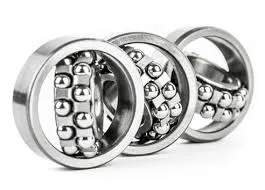
Nov . 21, 2024 00:12 Back to list
cylindrical roller bearing sizes
Understanding Cylindrical Roller Bearing Sizes
Cylindrical roller bearings are a vital component in numerous mechanical applications, known for their ability to handle high radial loads due to their design. These bearings consist of cylindrical rolling elements that help distribute the load evenly across the surface, reducing stress and improving efficiency. A comprehensive understanding of their sizes is crucial for selecting the appropriate bearing for a specific application, ensuring optimum performance and longevity.
What is a Cylindrical Roller Bearing?
Cylindrical roller bearings are designed to accommodate heavy radial loads while allowing for limited axial displacement between the shaft and housing. They can operate at relatively high speeds and provide lower friction compared to other bearing types. The key components of a cylindrical roller bearing include the inner ring, outer ring, rolling elements (the cylindrical rollers), and a cage that holds the rollers in place.
Size Specifications
When selecting a cylindrical roller bearing, several size specifications must be considered
1. Inner Diameter (ID) The inner diameter is the size of the bore hole that fits onto the shaft. It is critical that this measurement matches the shaft's diameter to ensure proper fitting and functioning.
2. Outer Diameter (OD) The outer diameter refers to the external size of the bearing. This parameter determines the bearing's housing compatibility and load distribution capabilities.
3. Width (B) The width of the bearing impacts its load-carrying capacity. A wider bearing can accommodate more rollers, distributing the load over a larger surface area and improving performance in high-load applications.
4. Roller Diameter (d) The diameter of the cylindrical rollers affects the bearing's overall behavior and performance under load. Larger rollers can support heavier loads but may also decrease the maximum rotational speed.
cylindrical roller bearing sizes

Classification and Variants
Cylindrical roller bearings come in various classes and designs, including
- Single-row cylindrical roller bearings These are the most common type, featuring one row of rollers. They are suitable for moderate load applications.
- Double-row cylindrical roller bearings With two rows of rollers, these bearings provide greater load capacity and stiffness.
- E-type bearings These are designed for heavier loads and typically have larger rollers and a wider cross-section.
- N-type and NU-type bearings These variants allow axial movement and are primarily used in applications requiring axial displacement.
Application Considerations
When selecting a cylindrical roller bearing, it is essential to consider the application environment. Factors such as temperature, speed, lubrication, and the presence of contaminants will influence bearing performance. For example, high-speed applications may require bearings with smaller roller diameters to reduce centrifugal forces, while harsher environments may necessitate sealed bearings to prevent contamination.
Conclusion
Understanding cylindrical roller bearing sizes is fundamental for engineers and technicians involved in design and maintenance across various industries, including automotive, aerospace, and machinery. Proper selection of bearing sizes ensures the reliability and efficiency of machinery, minimizes downtime, and enhances overall operational productivity.
By grasping the intricacies of the various dimensions and types of cylindrical roller bearings, one can better appreciate their roles in modern engineering. This understanding not only facilitates effective bearing selection but also contributes to the development of innovative solutions in mechanical design, thereby paving the way for advancements in technology and industry standards. Whether for heavy industrial machinery or precision instruments, cylindrical roller bearings remain an essential element in achieving optimal performance and reliability in mechanical systems.
Latest news
-
Premium Deep Groove Ball Bearings | High Speed & Reliability
NewsAug.29,2025
-
Durable Scaffolding Clamps - Secure & Reliable Tube Connectors
NewsAug.28,2025
-
Common Failures in Thrust Ball Bearings and Solutions
NewsAug.22,2025
-
How Tapered Roller Bearings Can Take Shock Loads
NewsAug.22,2025
-
Angular Bearings in High-Precision Spindles
NewsAug.22,2025
-
The Impact of Misalignment on Cylindrical Roller Bearing Performance
NewsAug.22,2025
